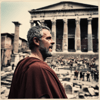Podcast
Questions and Answers
What was the primary role of the consuls in the Roman Republic?
What was the primary role of the consuls in the Roman Republic?
How did the Senate impact the government of the Roman Republic?
How did the Senate impact the government of the Roman Republic?
What was a key feature of the assemblies within the Roman Republic?
What was a key feature of the assemblies within the Roman Republic?
Who was responsible for interpreting the law in the Roman Republic?
Who was responsible for interpreting the law in the Roman Republic?
Signup and view all the answers
How did the system of consuls in the Roman Republic promote balance of power?
How did the system of consuls in the Roman Republic promote balance of power?
Signup and view all the answers
What role did the judges play in the Roman Republic's government?
What role did the judges play in the Roman Republic's government?
Signup and view all the answers
What was one of the major challenges faced by the Roman Republic?
What was one of the major challenges faced by the Roman Republic?
Signup and view all the answers
Which of the following is an enduring feature of the Roman Republic?
Which of the following is an enduring feature of the Roman Republic?
Signup and view all the answers
What was a primary responsibility of the consuls in the Roman Republic?
What was a primary responsibility of the consuls in the Roman Republic?
Signup and view all the answers
Which of the following best describes the main function of the Senate in the Roman Republic?
Which of the following best describes the main function of the Senate in the Roman Republic?
Signup and view all the answers
How did the assemblies contribute to the legislative process in the Roman Republic?
How did the assemblies contribute to the legislative process in the Roman Republic?
Signup and view all the answers
What was the role of judges in the Roman Republic's judicial branch?
What was the role of judges in the Roman Republic's judicial branch?
Signup and view all the answers
Which challenge was commonly faced by the Roman Republic's government?
Which challenge was commonly faced by the Roman Republic's government?
Signup and view all the answers
Which branch of government is correctly matched with its role?
Which branch of government is correctly matched with its role?
Signup and view all the answers
What contributed to the balance of power among branches in the Roman Republic?
What contributed to the balance of power among branches in the Roman Republic?
Signup and view all the answers
Which of the following is a similarity between the Roman Republic and modern democratic systems?
Which of the following is a similarity between the Roman Republic and modern democratic systems?
Signup and view all the answers
Study Notes
Roman Republic Government Structure
- The Roman Republic had a complex government with three branches: executive, legislative, and judicial.
- The executive branch was led by two consuls, elected annually, holding significant governmental and military power.
- Consuls could veto each other's decisions, creating a balance of power.
- The Senate, composed of patricians, was the most influential body in the Republic.
- The Senate advised consuls, managed finances, and handled foreign policy, serving a long-term role with life appointments.
- Multiple assemblies existed, like the Centuriate Assembly, Tribal Assembly, and Plebeian Council.
- These assemblies represented different citizen groups and participated in lawmaking and electing officials.
- Judges, or praetors, made up the judicial branch, interpreting laws and overseeing legal processes.
- Frequent elections, violence, and corruption posed challenges to the Republic.
Key Roles and Responsibilities
- Consuls: Head of government and military, law-proposing, and presiding over Senate and assemblies.
- Senate: Advising consuls, managing finances, and setting foreign policy.
- Assemblies: Electing officials, creating laws, and deciding important issues based on citizen representation.
- Judges (Praetors): Interpreting and applying laws fairly, overseeing legal proceedings.
Challenges and Enduring Features
- Challenges included violence, corruption, and frequent elections.
- Enduring features include elected leaders, an advisory Senate, and public forums for debate, influencing modern democratic systems.
Similarities and Differences Between Roman and Modern Governments
- Similarities include elected officials, advisory bodies (like a Senate), and public forums for debate.
- Differences involve the specific structures, citizen participation, and the methods for passing laws.
Studying That Suits You
Use AI to generate personalized quizzes and flashcards to suit your learning preferences.
Description
Explore the intricate government structure of the Roman Republic, which consisted of three branches: executive, legislative, and judicial. Learn about the roles of consuls, the influential Senate, and various assemblies in lawmaking and governance. This quiz delves into the balance of power and the challenges faced by this ancient governmental system.





